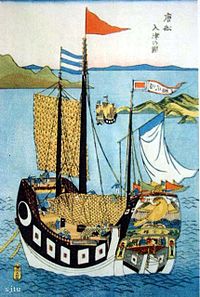Sakoku
From Wikipedia, the free encyclopedia.
Sakoku (Japanese: 鎖国, literally "country in chains") was the foreign relations policy of the Tokugawa shogunate, whereby nobody, whether foreign or Japanese, could enter or leave Japan on penalty of death. This lasted from 1641 to 1853 in the History of Japan, though the term was not coined until the 19th century. It was still illegal to leave Japan until the Meiji restoration.

In theory, the only foreign influence permitted was the Dutch "factory" (trading post) at Dejima in Nagasaki, but trade with China was also handled at Nagasaki; in addition, trade with Korea was conducted via Tsushima Province (today part of Nagasaki prefecture) and with the Kingdom of Ryukyu Islands via Satsuma Province (today's Kagoshima prefecture). Apart from these direct commercial contacts in peripheral provinces, all of these countries sent regular tributary missions to the shogunate's seat in Edo, which traveled long stretches across Japan, thus giving even regular folk a chance at a glimpse at foreign cultures.
The way Japan kept abreast of Western technology during this period was by studying medical and other texts in the Dutch language obtained through Dejima. This process was called "Rangaku" (Dutch studies). It became obsolete after the country was opened and the sakoku policy collapsed. Thereafter, many Japanese students (e.g. Kikuchi Dairoku) were sent to study in foreign countries, and many foreign employees were employed in Japan (see o-yatoi gaikokujin).
This policy ended with the Convention of Kanagawa in response to demands made by Commodore Perry.

